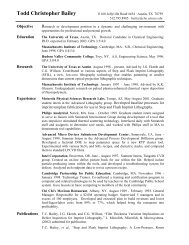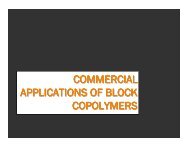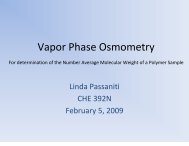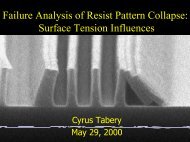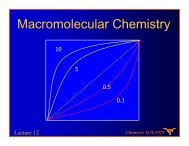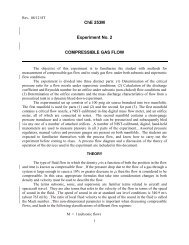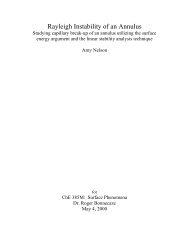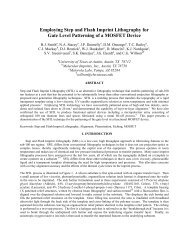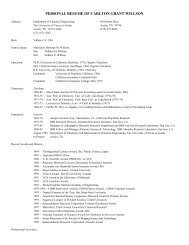Asymmetric fluid-structure dynamics in nanoscale imprint lithography
Asymmetric fluid-structure dynamics in nanoscale imprint lithography
Asymmetric fluid-structure dynamics in nanoscale imprint lithography
- No tags were found...
You also want an ePaper? Increase the reach of your titles
YUMPU automatically turns print PDFs into web optimized ePapers that Google loves.
Component Symbol Z-StiffnessRevolute Jo<strong>in</strong>t K RJ 4.1 × 10 9DC Mike Actuator K DC 5.0 × 10 7Quartz Force Sensor K FS 1.0 × 10 9Universal Jo<strong>in</strong>t K UJ 4.7 × 10 9Template Holder K TH 7.2 × 10 8Distributed Flexure R<strong>in</strong>g K RF 1.2 × 10 4Composite System Stiffness K Z 4.4 × 10 7 × 3Table 5.1 Mechanical system stiffness valuesThe equivalent <strong>in</strong>ertial terms, M and I, were computed fromPro/ENGINEER ® solid models. The equivalent mass is approximately 1.5 kg.The equivalent <strong>in</strong>ertia is approximately 5 × 10 -6 kg⋅m 2 . It is assumed that thedamp<strong>in</strong>g factor, ζ, for the mechanical system is 0.05. This gives the damp<strong>in</strong>gcoefficients asN⋅m⋅s.Ceq= 2ζK M , thus C Z = 1400 N⋅s/m and C θ = 2 × 10 -3eqeq5.2.3 Model of Actuation SystemThe actuator motion is taken as <strong>in</strong>put <strong>in</strong>to the mechanical system andassumed to have an ideal control scheme. The actuators are controlled by a PIDcontroller, which comes on board the Physik Instrument C-842 motor controller.65



